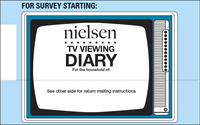 As Nielsen begins
implementing some of the biggest changes to its TV ratings methods since the introduction of the people meter, the world’s biggest media buyers say the researcher is ignoring a vital part of the
mix that is putting billions of TV advertising dollars at risk: the paper-and-pencil diary that is still the currency for most of America’s local TV markets.
As Nielsen begins
implementing some of the biggest changes to its TV ratings methods since the introduction of the people meter, the world’s biggest media buyers say the researcher is ignoring a vital part of the
mix that is putting billions of TV advertising dollars at risk: the paper-and-pencil diary that is still the currency for most of America’s local TV markets.
In a white paper being released this morning, the American Association of Advertising Agencies is calling on Nielsen to take
immediate steps to address the eroding performance of its diary sample, which will still be the basis for billions of dollars in local TV buys -- even after Nielsen implements its other methodological
changes, some of which are intended to improve local TV audience measurement.
advertisement
advertisement
The white paper characterizes 4As members as being “cautiously optimistic” about those
changes, which include controversial modeling techniques that will estimate audiences in non-people meter markets based on data from people meter markets, but said they still need to be assessed by
the industry and validated and accredited by industry self-regulatory ratings watchdog, the Media Rating Council. Assuming that happens, the 4As task force says audience ratings in more than half of
all TV markets will still be dependent on paper diaries, which are growing increasingly unstable and unreliable due to the hyper-fragmentation of TV viewing options.
“The diary
was designed decades ago, when the media environment was not nearly as complex as it is today,” Jon Cogan, director of investment research and insights at Omnicom’s Annalect unit, told
MediaDailyNews during an advanced briefing on the white paper. Cogan, who is co-chair of the 4As task force, said that assuming Nielsen successfully implements its other proposed changes,
more than half of all TV markets will still depend on diaries.
Brad Adgate, the task force’s other co-chair and the primary author of the white paper, noted that there is a law
of diminishing returns for local TV audience measurement, because the smallest TV markets represent disproportionately lower shares of TV viewing and TV ad buys, but it will still represent
“billions of dollars,” making it bigger than many digital media that are getting far more audience measurement attention.
“The story is that there have been a lot
of initiatives in audience measurement in the past year, particularly in digital media, but the local TV diary is still the currency for measurement for billions of dollars and we just want Nielsen to
know there’s a need to improve this, even while they are focusing on improving other things,” Adgate explained.
In particular, Adgate said the task force recommends that
Nielsen implement relatively simple steps to boost “cooperation rates” and lower “non-response bias” in diary-only markets. While those steps -- things as simple as issuing
more diaries per market -- may not be complex, they likely would cost Nielsen more money to implement and come at a time when its organization is focused on bigger fish, so the 4As is pushing Nielsen
to keep its eye on the local TV marketplace ball.
“Nielsen should do these things simultaneously,” he said.
Currently, the task force estimates
Nielsen’s diary methods impact about $7.5 billion in local TV advertising buys. Even after Nielsen completes other proposed changes, Adgate estimated that more than half of all TV markets will
still rely on diary ratings, putting billions of dollars at risk at a time when advertisers and agencies are shifting to digital media anyway.
Both Cogan and Adgate conceded that
eventually, the diary will have to be replaced by a better method capable of estimating the current and future TV viewing environment, but in the meantime, there are some simple steps that can be
taken to boost the existing diary method.
“It’s a paper and a pencil,” noted Adgate, adding: “It’s not going to take a lot of money to improve it. There are a lot of
improvements that can be done simply by recruiting more of the hard-to-reach respondents.”